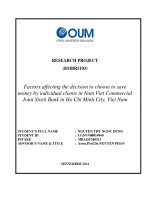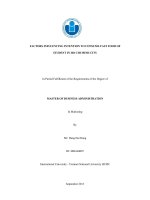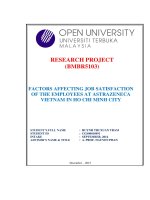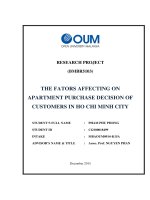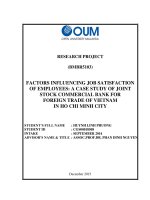Research about factors affect to customers’ satisfaction when using atm card products at donga bank, tan binh branch, ho chi minh city
Bạn đang xem bản rút gọn của tài liệu. Xem và tải ngay bản đầy đủ của tài liệu tại đây (1.07 MB, 45 trang )
OUM
OPEN MALAYSIA UNIVERSITY
RESEARCH PROJECT
(BMBR5103)
RESEARCH ABOUT FACTORS AFFECT
TO CUSTOMERS’ SATISFACTION
WHEN USING ATM CARD PRODUCTS
AT DONGA BANK, TAN BINH BRANCH,
HO CHI MINH CITY
STUDENT’S FULL NAME
: VO HUYNH DUC
STUDENT ID
: CGS00064987
INTAKE
: MARCH, 2016
ADVISOR'S NAME & TITLE
: DR. BUI PHI HUNG
AUGUST, 2017
Advisor’s assessment
....................................................................................................................................................................
....................................................................................................................................................................
....................................................................................................................................................................
....................................................................................................................................................................
....................................................................................................................................................................
....................................................................................................................................................................
....................................................................................................................................................................
....................................................................................................................................................................
....................................................................................................................................................................
....................................................................................................................................................................
....................................................................................................................................................................
....................................................................................................................................................................
....................................................................................................................................................................
....................................................................................................................................................................
....................................................................................................................................................................
....................................................................................................................................................................
....................................................................................................................................................................
Advisor’s signature
CONTENTS
Chapter I: Introduction……………………………………………………………….1
1.1
Research background.............................................................................................1
1.2
Objectives of the study...........................................................................................1
1.3
Research Methodology...........................................................................................2
1.4
Subjects and scope of study....................................................................................2
1.5
Structure of the Paper.............................................................................................3
1.6
Structure and content of research topics.................................................................3
Chapter II: Literature review.........................................................................................4
2.1
Payment card overview.........................................................................................4
2.1.1
Some basic concepts about payment cards...........................................................4
2.1.2
Card classification.................................................................................................4
2.2
Utilities when using the card.................................................................................4
2.3
Process of issuance, payment by ATM card.........................................................5
2.4
Consumer behavior........................................................................... ...................6
2.5
Customer satisfaction index model ......................................................................6
2.5.1
Building the model................................................................................................7
2.5.2
Method of measurement of satisfaction indicators..............................................10
2.5.3
Application of customer satisfaction index in strategic planning.........................11
2.5.4
Customer satisfaction............................................................................................11
2.5.5
Service quality......................................................................................................12
2.5.6
Parasuraman service quality distance model........................................................12
Chapter III: Research Methodology..............................................................................14
3.1
Research design..................................................................................................14
3.1.1
Collect information.............................................................................................14
3.1.2
Research Methods...............................................................................................15
3.1.2.1
Preliminary research...........................................................................................15
3.1.2.2
Formal study:......................................................................................................15
3.2
Develop ATM service quality scale....................................................................16
3.3
Develop a measure of customer satisfaction:......................................................17
Chapter IV: Analysis and Research Results ................................................................23
4.1
Scale analysis.....................................................................................................23
4.1.1
Cronbach's alpha scale analysis.........................................................................23
4.1.2
Factor analysis...................................................................................................26
4.2
Accreditation of theoretical models...................................................................28
4.2.1
Pearson correlation coefficient analysis.............................................................29
4.2.2
Regression analysis............................................................................................30
4.2.3
Evaluate the quality of ATM card services currently offered by DongA Bank,
Tan Binh Branch……………………………………………………………………........33
4.2.3.1
About service efficiency and customer support................................................33
4.2.3.2
On tangible means.............................................................................................34
4.2.3.3
About credibility...............................................................................................35
Chapter V: Conclusion and solution .............................................................................37
5.1
The proposal effectively serve and support the client.....................................37
5.2
Conclude.........................................................................................................39
References........................................................................................................................ 40
FIGURE
Figure 1: Card payment process
Figure 2: Model 5 stage decision making to purchase goods or services
Figure 3: American Customer Satisfaction Index – ACSI
Figure 4: European Customer Satisfaction Index – ECSI
Figure 5: Theoretical model of satisfaction indicators of banks
Figure 6: Strategic planning model for customer-centered customer satisfaction
Figure 7: Service quality model (Parasuraman, 1988)
TABLES
Table 3.1: Sample sex information
Table 3.2: Age sample information
Table 3.3: Sample Information on educational level
Table 3.4: Sample information on personal income
Table 4.1: Results of the Cronbach's alpha coefficient analysis
Table 4.2: Results of the analysis of the factors of the service quality scale
Table 4.3: Results of factor analysis of customer satisfaction scale
Table 4.4: Correlation matrix between variables
Table 4.5: Results of multiple regression analysis
ACRONYMS
DongA Bank: Joint stock commercial bank of East Asia
TC: Reliability
HQ: Effective
NL: Capacity
DC: Empathy
PT: Tangible Media
HL: Satisfaction
Vo Huynh Duc
CHAPTER I: INTRODUCTION
1.1. Research background:
The bank card market in Vietnam is currently developing very vibrant, especially
domestic debit cards (ATM cards) with more than 40 banks involved in issuing these cards,
including state-owned commercial banks, Joint stock commercial banks, joint venture
banks and foreign bank branches. With a population of over 80 million and a young
population structure, Vietnam is considered a potential market for the development of this
modern service. Therefore, the tough competition between banks will inevitably take place
to attract target customers to their banks. Therefore, in order to improve competitiveness
and expand market share, researching customer satisfaction when using ATM card services
is an important issue that needs to be paid due attention.
At DongA Bank, Tan Binh Branch, there is no formal study related to the quality of
ATM card services provided and the level of customer satisfaction when using these card
services. The bank, as a service provider, must be responsible for providing quality
products, regard customers as subjects, the one who bring the income to the bank itself.
As for customers, they have a product of their choice that can meet and satisfy their
requirements.
In the future, the use of non-cash payment services will become popular and close
to the people of Vietnam, especially card services. Therefore, banks that want to maintain
and develop this service need to accurately measure the quality of their card services,
thereby improving their ability to meet the increasing demands of their customers.
1.2. Objectives of the study:
This study provides an overview of the ATM cards of DongA Bank and thereby
assesses the quality of ATM card services offered by DongA Bank. The objective
evaluation of customers has an important significance to help the bank go in the right
direction to improve the quality of ATM card related services.
Specific objectives include:
Page 1
Vo Huynh Duc
- Measuring the quality of ATM services of DongA Bank.
- Recognizing clearly the opinions of customers about the quality of ATM card
services provided by the bank.
1.3. Research Methodology:
What research method do we choose? And how to follow the process? Here we
choose the quantitative method.
Quantitative research methods include:
- Probe study: Prior to the formal study, the survey was conducted in a total of 50
clients to identify errors in the design of the questionnaire, the missing content needed to
be added.
- Official study: Through consultations with card specialists, the variables of
observation have been modified and adapted to the interviewees. The official study was
conducted with a sample size of 200 clients working at companies paid monthly through
their accounts opened at the DongA Bank, Tan Binh Branch.
- What interviewing method is used?: Investigation by answering the questionnaire
in the form of a letter of inquiry through colleagues working in the marketing team of Sales
Department of Card Services at DongA Bank, Tan Binh Branch.
- Survey time and response rate? : The official study is expected early in June 2017,
the survey period is about 2 weeks, estimated response rate is over 90% because customers
are interested and respond to this survey according to preliminary research.
- Using analytical methods? How to test the research model? This study uses factor
analysis to extract the elements of quality ATM card services that affect customer
satisfaction
- SPSS software is used to test the research model.
1.4. Subjects and scope of study:
To complete this essay, we seek answers to the following questions:
Page 2
Vo Huynh Duc
This study was conducted in Ho Chi Minh City. Who are the interviewees? Where?
In this survey, the selected respondents were employees working for companies paying
salary via DongA Bank, Tan Binh Branch.
1.5. Structure of the Paper:
Research topics bring some practical implications:
- As a service provider, will DongA Bank accurately assess the services of its ATM
card to meet the needs of customers? Through this, the bank continues to have more
investment in technology, people and diversification of ATM card related products in order
to satisfy not only the needs and increasing demands of traditional customer, but helps to
motivate potential customers, especially young people, to see the convenience of using
modern means of payment.
- This research helps customers better understand the ATM card service that they
have been using, eliminating the notion that the use of ATM cards is only to withdraw cash
at the ATM. From there, customers can use ATM card services in the most effective way.
- Other commercial banks that are issuing ATM cards or preparing to market this
service may use this research as a reference in their development strategy.
- Other commercial banks that are issuing ATM cards or preparing to market this
service may take this research as a reference in their development strategy.
1.6. Structure and content of research topics
In addition to the introduction and conclusion, the research topic is divided into
five chapters, namely:
- Chapter 1: Introduction.
- Chapter 2: Literature review
- Chapter 3: Methodology
- Chapter 4: Result.
- Chapter 5: Conclusion and solution.
Page 3
Vo Huynh Duc
CHAPTER II: LITERATURE REVIEW
2.1. Payment card overview:
2.1.1. Some basic concepts about payment cards:
A payment card is a non-cash payment that the cardholder can use to withdraw cash
or pay for goods or services at places where cards are accepted.
2.1.2. Card classification:
At present, there are following cards in the domestic payment market:
-
Debit card: For this card, the user does not have to deposit money into the bank
account to ensure payment card. The limit of the debit card is the balance on the
cardholder's deposit account at the bank. Debit cards usually apply to customers who have
regular business relationships.
-
Credit Card: Credit Card is the type of card that the bank gives the customer a
loan to use on the card account. The limit of the card is also the credit limit that the bank
lends to the borrower. Credit card applies to customers who qualify for a bank loan.
-
Margin card: This type of card is applied to all customers with a deposit in the
account. Limit of the main card is the amount deposited by the customer to the account to
use for his card.
2.2. Utilities when using the card:
-
For issuing banks: Generate regular income for the bank issued by the annual
fee that cardholders have to pay to the bank. Recharging the account by cardholders to use
the card facilitates banks to mobilize funds from customers' demand deposits. In addition,
ATMs or card accepting places also contributes to the expansion of the bank's network.
-
For cardholders: When using the card, the cardholder is provided by a bank with
a high security payment service and great convenience. In addition, when the customer has
a balance on the account, if the customer does not use, this balance will be entitled to
interest rates of demand deposits. The use of credit cards or payment cards ensures the
ability to use in multiple currencies, regardless of the foreign currency of any country.
Page 4
Vo Huynh Duc
-
For reimbursing bank: With charges such as commercial discounts, cash
withdrawal fees, agent fees, reimbursing banks could get a relatively stable revenue. In the
card payment process, issuers usually open accounts at banks for payment. This increases
the amount of deposits and deposits for the reimbursing bank.
-
For card payment accepting places: By providing advance credit to customers,
the bank helps customers spend more than they can afford, which is a boost to customer
purchasing power, and this will lead to higher consumer spending. The service of the card
accepting places is soaring. When accepting payment cards, sellers are able to minimize
the costs of cash management such as preservation, counting, remitting into bank accounts,
enjoying bank preferences on credit, payment service...
2.3. Process of issuance, payment by ATM card
The process of issuing card payment is as follows:
Figure 1: Card payment process
(1) The customer shall make a written request for payment card issuance to the
Bank.
(2) When the bank agrees, the card issuing bank shall carry out procedures to issue
the card for customers to use and instruct the customer how to use the card.
(3) The cardholder presents the card to the receiver when purchasing goods or
services. Card receivers put into the card payment machine, the machine automatically
record the payment amount and print the payment receipt.
(4) The person who receives the card returns the card giving the payment slip to
Page 5
Vo Huynh Duc
the cardholder.
(5) The card acceptor makes a list of payment receipts and remits it to the
correspondent bank.
(6) Where the correspondent bank receives the payment receipt attached to the
payment receipt statement, the card paying agency shall pay immediately to the card
acceptor.
(7) Correspondent banks transfer the invoice and payment document to request the
issuing bank to make a payment.
(8) Banks issue makes payments to correspondent payment banks.
2.4. Consumer behavior:
Consumer behavior research is the focus of marketing research. To succeed in
marketing, the first thing is to understand why consumers act and how they act.
Definition: Consumer behavior is the act of a person who conducts the purchase and
use of a product or service, including the psychological and social process before and after
the occurrence of the act.
The buying decision process is a series of stages that consumers spend in making a
decision to buy a product or service. That process consists of 5 stages:
Figure 2: Model 5 stage decision making to purchase goods or services
2.5. Customer satisfaction index model:
Origin: Since the 1970s, customer behavior researchers in developed countries have
begun to undertake in-depth studies of customer satisfaction such as Oliver (1977),
Page 6
Vo Huynh Duc
Churchill And Suprenant (1982), Olshavsky (1993) and Fornell (1989), along with
colleagues at the University of Michigan, helped Sweden establish the world's first
customer satisfaction measurement system at the national level. In later years, this index
was developed and widely used in developed countries such as USA - ACSI, Norway NCSI, Denmark - DCSI and EU countries - ECSI (1998).
Figure 3: American Customer Satisfaction Index – ACSI
2.5.1. Building the model:
Through the American Model of Satisfaction Index (ACSI), the perceived value
is influenced by the perceived quality and expectations of the customer. Then, the
expectations of customers have a direct impact on the perceived quality. In fact, the higher
the expectations, the higher the quality of customer perception of the product or vice versa.
Therefore, the quality requirements of products and services provided to customers need
to be ensured and satisfied on the basis of their satisfaction. Customer satisfaction is built
on the basis of perceived quality, expectation and perceived value, if quality and perceived
value are higher than expected to create loyalty to the customer. In the opposite case, this
is a complaint or blaim about the product they are consuming.
Page 7
Vo Huynh Duc
Figure 4: European Customer Satisfaction Index – ECSI
The European Comfort Index (ECSI) model has some distinct differences.
Compared to ACSI, the image of the product or brand has a direct impact on customer
expectations. At that time, customer satisfaction is the combined effect of 4 visual
elements, perceived value, perceived quality both tangible and intangible. Typically, the
ACSI is generally applicable to the public sector, while the ECSI is often used to measure
products and industries.
Clearly, the strength of this approach is that it immediately shifts the consumer
experience, facilitating the study of the causal relationship between the constituent
components of customer satisfaction and loyalty.
Page 8
Vo Huynh Duc
Figure 5: Theoretical model of satisfaction indicators of banks
Researchers have developed a model of customer satisfaction index applied to most
banks. Based on the results of the model study of the countries, the theoretical model of
customer satisfaction index of the Bank includes the following specific factors:
Image: The image expresses the relationship between the brand and the association
of the customer with the attributes of the brand. This variable is expressed by the reputation,
prestige, trust of the consumers themselves with the brand. Practical research has
confirmed that this is an important factor and has a direct impact on customer satisfaction.
Expectations: Express the level of quality that customers expect to receive, the
parameters that measure the expectations associated with the parameters of the image and
the perceived quality of the product and service. This is the result of previous consumer
experience or information through media channels for the product or service. In fact, the
higher the expectations, the more likely it is that you will be able to make a purchase
decision but the higher your expectations, the more likely the bank will satisfy the
customer.
Page 9
Vo Huynh Duc
Perceived quality: For the bank, the quality of perception is the quality of the
perceived product or service. With intangible features, banking products considered in this
case are loan terms, the time from the loan application to the loan, the style of the manager
and the consultants, Air at the counter, post-borrowing commitments and other binding
conditions ...
Perceived value: Theoretical studies show that customer satisfaction depends on the
perceived value of goods and services. Value is the level of appreciation / perception
toward the quality of the product compared to the price paid or the "value not only in
money" aspect that the consumer consumes the product. Customer value is the difference
between the total value a customer receives and the total cost that a customer pays for a
product or service. For a bank, it is the total amount to pay, the costs of time, effort and
other risk costs relative to the value of the service (tangible benefits), psychological value,
trust And human value. The difference between value and cost is the perceived value that
banking services bring to customers.
Price: This is the new variable proposed for consideration in the theoretical model.
Loyalty: It is the ultimate variable in the model and is critical to the survival of the
bank in the future, measured by the intention to continue to buy, trust, and recommend to
others for products and services. They are using. In contrast to loyalty is the complaint
when customers are not happy with the product or service compared to their expectations.
Customer loyalty is seen as a bank asset. Therefore, banks need to create satisfaction with
customers that enhance their loyalty to the bank.
2.5.2. Method of measurement of satisfaction indicators
Qualitative research will identify the indicators that need to be measured in each
variable. For example, for banks, image variables are measured by the prestige, the number
of branches traded, the automatic channel, the stability of the business process, the air in
the delivery process. Factors in visual variables, expectations, perceived quality, perceived
value, loyalty (complaint) are often "quantified" through the Likert scale from 5 to 10
options and Customer satisfaction variables typically use a 10 or 100 scale. The variable's
Page
10
Vo Huynh Duc
point is the mean of the items used to form the variable. After the data collected from the
customer, factor analysis and reliability analysis tools can be used to examine the
similarities in the establishment of variables. Numbers from specific elements (items).
2.5.3. Application of customer satisfaction index in strategic planning
Figure 6: Strategic planning model for customer-centered customer satisfaction
2.5.4. Customer satisfaction:
Customer satisfaction is considered the cornerstone of the marketing concept of
satisfying customer needs and expectations (Spreng, MacKenzie, & Olshavsky, 1996).
Satisfied customers are an important factor in maintaining long-term business success and
appropriate business strategies to attract and retain customers (Zeithaml & GCT, 1996).
The quality is now evaluated on the customer perspective. A good product means
fulfilling or even exceeding customer expectations and satisfying the customer.
According to Kotler (2006), satisfaction is the level of a person's sense state that
results from comparing the perception of a product to his or her expectations. Accordingly,
satisfaction has the following levels:
Page
11
Vo Huynh Duc
Level of dissatisfaction: The level of customer perception is smaller than expected.
Satisfaction level: The level of customer perception is equal to the expectation.
Very satisfied: The level of customer perception is greater than expected.
2.5.5. Service quality:
Quality of service is defined in many different ways depending on the research
subject and the research environment. Quality of service is the extent to which a service
meets the needs and expectations of customers (Lewis & Mitchell, 1990; Asubonteng &
ctg, 1996; Wisniewski & Donnelly, 1996). Edvardsson, Thomsson & Ovretveit (1994)
argue that service quality is a service that meets the expectations of customers and satisfies
their needs. According to Parasuraman & ctg (1985, 1988), service quality is the distance
between customer expectations and their perceptions when used through the service.
In short, quality of service is a factor that affects customer satisfaction. Want to
improve customer satisfaction, service providers need to improve service quality. In other
words, quality of service and satisfaction are closely interrelated. In it, the quality of service
is what first creates, decides the satisfaction of customers.
2.5.6. Parasuraman service quality distance model:
Parasuraman & ctg (1985, 1988) have put forward a five-distance service quality
model. This model is presented as follows:
Page
12
Vo Huynh Duc
Figure 7: Service quality model (Parasuraman, 1988).
Inside:
Difference 1: Appears when there is a difference between a customer's expectations
and a manager's perception of customer expectations.
Difference 2: Appears when the service manager misrepresented or failed to
communicate the customer expectations into the quality process.
Difference 3: Appears when the employee is working incorrectly or otherwise. The
service officer does not deliver the service to the customer according to the defined criteria.
Difference 4: Occurs when advertising and misrepresentation reduce the quality that
customers feel when they are not doing what they promise.
Page
13
Vo Huynh Duc
Difference 5: Appears when the deviation between the service received and the
expectations of the customer. And this difference depends on the previous distance, ie to
increase the quality of service or shorten the 5th distance, efforts must be made to shorten
the distance.
The distinct year model is the general model, according to Parasuraman. Any quality
service is also perceived by customers based on five components:
Reliability: the ability to deliver the service as promised to the customer.
Responsiveness: expresses the willingness and willingness of service personnel to
provide timely service to customers.
Competence: trust, safety, professionalism of service personnel.
Empathy: access to information, understanding customers. Show the interest of
employees with customers.
Tangibles: equipment for service and outfit, appearance of employees.
CHAPTER III: RESESEARCH METHODOLOGY
3.1. Research design:
After determining the model of factors affecting the quality of ATM card service
and customer satisfaction using the card in chapter 1, the author will present a detailed
study plan such as: Which research methodology for the model, how to collect information,
using what scale to analyze ...
3.1.1. Collect information:
During the study, the author used two sources of information:
-
Primary information:
+ Questionnaires received from customers.
+ Interview results, discussion with Bank staff / leaders to get a clearer view of
their views, plans and assessments of research issues.
-
Secondary information:
Page
14
Vo Huynh Duc
Theoretical foundations and selected articles in marketing magazines and bank
magazines are secondary sources of information for research purposes. The sources of
information for the secondary data are as follows:
+ Bank Magazine
+ Marketing Magazine
+ Speeches on service and quality of service
+ Lecture on Research Methods and Data Analysis SPSS
+ Report on business activities of DongA Bank, Tan Binh Branch
+ Information from the Internet
3.1.2. Research Methods:
In order to assess the quality of ATM card services of DongA Bank and the level of
satisfaction of customers using this service, the author has used quantitative research
method. The research process was conducted through two main steps: preliminary research
using quantitative and qualitative methods using quantitative methods.
3.1.2.1. Preliminary research:
Prior to the formal study, the survey was conducted in a total of 50 clients to identify
errors in the design of the questionnaire, the missing content needed to be added.
3.1.2.2. Formal study:
- Method of collecting information and sample size
Through consultations with card specialists, the variables of observation have been
modified and adapted to the interviewees. The official study was conducted in Ho Chi
Minh City with a sample size of 200 clients working in five companies paying their
monthly salary through accounts opened at DongA Bank, Tan Binh branch.
Selected companies include:
+ Vitaco Petroleum Transportation Joint Stock Company.
+ State Capital Investment Corporation (SCIC).
+ Saigon Marine Joint Stock Company.
+ Hong Ngoc Ha Trading Service Co, Ltd.
Page
15
Vo Huynh Duc
+ ILA Vietnam Co, Ltd.
Sampling is randomly selected in combination with filtered objects. Accordingly,
in order to ensure the reliability of the data set to be collected, the criterion for selection of
the company to be surveyed is the duration of using the paid service through DongA Bank,
Tan Binh Branch for 1 year or more. And regular invoicing of service bills through the
account.
According to the plan, 200 questionnaires will be sent to the customers in two forms:
direct mail to customers or marketing staff will contact the payroll department personnel.
Pay through the account to send questionnaires.
After two weeks, the author received 175 votes, of which 4 were invalid due to
multiple vacancies. Thus, after eliminating four invalid votes, the remaining 171 votes met
the required sample size for analysis.
-
Data analysis plan:
With the data collected from the survey, after conducting the data cleaning and
validation, some of the methods used in the study are as follows:
-
Descriptive statistics:
+ The data set after coding and calibration will be included in the description of
the attributes of the sample group such as sex, age, education level, income…
+ Use the Cronbach Alpha coefficient to test the reliability of the observed
variables in the dataset by the factorization of the model.
-
Factor analysis:
After checking the reliability of the observed variables. Factor analysis is used to
collapse data and identify the set of variables needed to prepare for subsequent analysis.
-
Sample description:
As mentioned in the sections above, there are 171 valid votes used as data for the
next analysis. The results of aggregating personal information of customers are described
in detail as follows:
+ About sex:
Page
16
Vo Huynh Duc
Sex
Male
Female
Total
Absolute
frequency
(person)
88
83
171
Relative
frequency
(%)
51.5
48.5
100
Valid
frequency
(%)
51.5
48.5
100
Cumulative
frequency
(%)
51.5
100
Table 3.1: Sample sex information
Thus, there are a total of 88 male customers accounting for 51.5% and 83 female
customers, accounting for 48.5% of the total of 171 clients surveyed. From the above
results, it can be seen that the gender structure of customers using ATM card service of
DongA Bank is similar.
+ About age:
Age
From 18 – 30
From 31 – 40
From 41 – 50
From 51 – 60
Total
Absolute
frequency
(person)
89
60
18
4
171
Relative
frequency
(%)
52.3
35.4
10.7
1.6
100
Valid frequency
(%)
52.3
35.4
10.7
1.6
100
Cumulative
frequency
(%)
52.3
87.7
98.4
100
Table 3.2: Age sample information
From the above table, there are 89 customers in the age group of 18-30 years,
accounting for 52.3%; 60 customers in the age group from 31 to 40, accounting for 35.4%;
18 clients in the age group from 41 to 50 years, accounting for 10.7% and the group of
customers from 51 to 60 years old is 4 people, accounting for 1.6% of the total four age
groups surveyed. Through these figures, it can be seen that young people are very interested
in ATM card services because of this new, modern, safe and fast payment method.
+ About education
Page
17
Vo Huynh Duc
Absolute
frequency
(person)
9
55
91
16
171
Level
High school
Intermediate, college
University
After university
Total
Relative
frequency
(%)
5.3
32.4
53.5
8.8
100
Valid
frequency
(%)
5.3
32.4
53.5
8.8
100
Cumulative
frequency
(%)
5.3
37.7
91.2
100
Table 3.3: Sample Information on educational level
The educational level of the surveyed clients is divided into four groups, of which
9 are high school students, accounting for 5.3%; The middle and junior college group had
55 people, accounting for 32.4%; The university group consisted of 91 students, accounting
for the highest rate of 53.5% and the graduate group of 16 students, accounting for 8.8%.
With this result, the higher education level, the higher the quality of ATM card service they
are using, as they are aware of the advantages of ATM card payment method bring.
+ About income:
Personal income
(VND/month)
Under 4 million
From 4 to 10 million
From 10 to 20 million
Over 20 million
Total
Absolute
frequency
(person)
37
99
29
6
171
Relative
frequency
(%)
21.5
57.9
17.1
3.5
100
Valid
frequency
(%)
21.5
57.9
17.1
3.5
100
Cumulative
frequency
(%)
21.5
79.4
96.5
100
Table 3.4: Sample information on personal income
Results of income survey of 171 customers showed that customers with income
below VND 4 million were 37 people, accounting for 21.5%; 99 people earn from 4 to 10
million, accounting for the highest rate is 57.9%; 29 people have income from 10 to 20
million with the corresponding ratio is 17.1% and the income above 20 million has 6 people
corresponding to the rate of 3.5%.
3.2. Develop ATM service quality scale:
Page
18
Vo Huynh Duc
In order to measure the quality of ATM card services, the author uses the five-digit
distance scale of Parasuraman adjusted for card services in Vietnam, Specific:
-
Research models: Factors affecting the quality of ATM card services are
expressed by 31 variables of observation, Inside:
+ Trusted Composition: Represent the bank's credibility and credibility with
customers, including seven observation variables (from questions 1 to 7).
+ Service Performance Components: demonstrated by the ability to quickly
resolve customer inquiries related to ATM card services, including 5 observation variables
(from questions 8 to 12).
+ Capacity component: demonstrated through the expertise and attitudes of the
cardholder, including the 8 observation variables (from questions 13 to 20).
+ Empathy: It is sympathy, caring, attentive customer care, giving customers
the best possible service. This component is measured by four observable variables (from
questions 21 to 24).
+ Tangible means of transportation: assessed by the external image of ATM
facilities, the appearance and costumes of staff, including 7 observation variables (from
questions 25 to 31).
-
The hypothesis of the model:
+ Ho: The more reliable the components, the more satisfied the customer
+ H1: The higher the customer service performance, the higher the customer
satisfaction
+ H2: The better the service component, the higher the customer satisfaction
+ H3: The empathy component is highly appreciated by customers, the higher
customer satisfaction
+ H4: The higher the visibility of the tangible components, the higher the
customer satisfaction.
-
Encrypt data:
Page
19
Vo Huynh Duc
After collecting the appropriate sample size, the author used the SPSS tool to
analyze the data with encoded scales as in the following table:
Numerical
Encode
order
Electrolyte
RELIABILITY
1
TC01
The bank performs ATM card services exactly as it was
introduced.
2
TC02
The bank always protect customer information.
3
TC03
When you have questions or complaints, the bank is always
resolved satisfactorily.
4
TC04
Banks are trusted by customers.
5
TC05
6
TC06
7
TC07
The bank provides ATM card services right at the time the bank
promises.
The bank implements the ATM card service right from the first
time.
The ATM system always works well.
EFFECTIVE SERVICE
8
HQ01
The staff of the bank always serve customers quickly, timely.
9
HQ02
Bank staff are always available to assist clients.
10
HQ03
11
HQ04
12
HQ05
Bank staff provide full and easy-to-understand customer
procedures.
Bank staff always respond promptly to the requirements of
customers.
The bank has clear and erroneous transaction documents and
related documents
SERVICE CAPABILITIES
13
NL01
The bank staff serves polite, courteous customers.
14
NL02
Bank employees handle the business quickly, accurately.
15
NL03
Bank staff always provide the necessary ATM card information
services to customers.
Page
20



